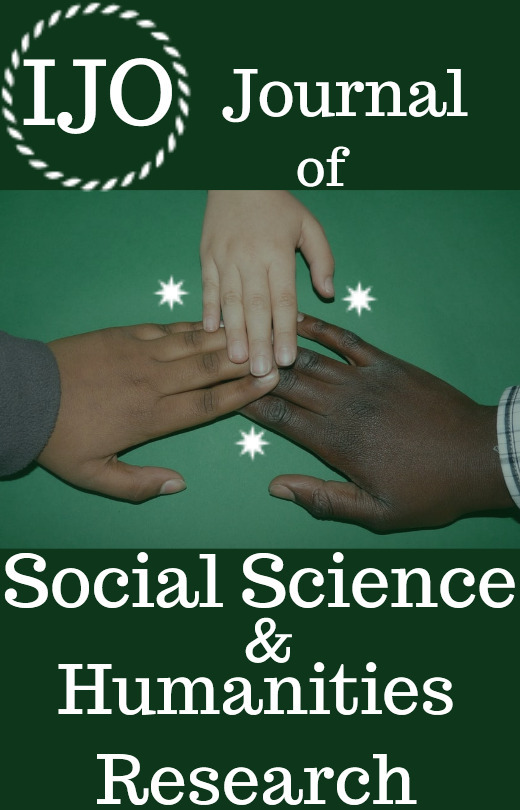Illicit Drug Use and The Challenges of addiction
Abstract
The challenge is illicit drugs use and addiction can not be over emphasised in our society today, based on this study Drug addiction was found to be prevalent among road transport workers. This is in agreement with the respondents’ responses from the in depth interview conducted by the researcher the influence drug addiction were found to include peer/co-worker influence, depression, stress, frustration, family background, low self-esteem, desire to stay active etcFactors that influence drug addiction were found to include peer/co-worker influence, depression, stress, frustration, family background, low self-esteem, desire to stay active etc. This finding is supported by responses from the in-depth interview and also by the works of other scholars. Findings from the study influenced the study recommendations amongst which it identified provision of rehabilitative programs to affected members, sanctioning of drivers under the influence of substance, restricting the advertisement and availability of these products in their place of work and enlightening them on the health hazards as the various strategies that can be applied to curb drug addiction among road transport operators.
References
Ajibade D. and Adefolaju T., (2017). Rationale and Implications of Psychoactive Substances Use Among Commercial Road Transport Workers in Lokoja, Nigeria. Mediterranean Journal of Social Sciences 8 (5) 143-157.
Ajibade, B.L, Uvomata, M.Ebele, Akinpelu, A.O., Adeleke, M.A., Fabiyi B.O., Akinlabi, Tosin, (2016). Factors Influencing Substance Abuse Amongst Selected CommercialMotorcyclists in Ogbomoso Metropolis, Oyo State, Nigeria. International Journal ofHealth and Psychology Research, 4 (3) 1-27.
Alexander A.O, (2013). Exploring Peer Influence as a Pathway to Adolescent Substance abuseinNigeria.
Alti-Muazu M, Aliyu AA., (2008). Use of psychoactive substances among commercialmotorcyclists in Zaria, Nigeria. Ann Afr Med.;7(2):67-71.
Department of Social Development, (2008). Drug Use and Misuse. Private Bag Publisher.Limpopo Province.
Fareo, D., (2012). Drug Abuse among Nigeria Adolescents Strategies for Counselling. The Journal of International Social Research, 5(20) 341-347.
Fekjaer, H., (1992). Alcohol as an Intoxicant. World Health Forum. International Journal of Health Development, 13: 366.
Girotto E., Mesas, A.E., deAndrade, S.M &Birolim. M. M (2014). Psychoactive substance use by truck drivers: a systematic review,Occupational and Environmental Medicine,71, 71-76
Girotto, E., deAndrade, S.M., Mesas, A.E., Gonzalez, A.D &Guidoni, C.M (2015). Workingconditions and illicit psychoactive substance use among truck drivers in Brazil,Occupational and Environmental Medicine, 72,764-9.
Grace, A. & Maria, I. (2014) Prevalence of alcohol consumption among commercial drivers.Journal of sports and physical education. 1 (5) 47-51
Gupta A (2012). Drug/alcohol addiction in India–Disturbing trends. Online available on:http://www.gatewayforindia.com/articles/addiction.htm.
Kingsley M., Gabriel N., Olubukola O., Kenneth Y., (2017). Psychoactive substance use in asample of community outreach participants; Prevalence, Correlates and Ease of Incorporating Care. International Journal of Research in Medical Sciences 5(7):2845- 2853.
Lasebikan, V. and Baiyewu, O., (2009). Profile of Problems Associated with Psychoactive Substance Use among Long Distance Commercial Automobile Drivers in Ibadan. Nigerian Journal of Psychiatry. 7, p 9-13.
Lone and Mircha, (2013). Drug addiction and the Awareness Regarding its Possible Treatment and Rehabilitation of Young Drug Users in Kashmir. International NGO Journal,8 (4), pp. 80-85
Marian Jeˆdrzejczak, and Marian Jeˆdrzejczak, (2005). Family and Environmental Factors of Drug Addiction among Young Recruits. Journal of Military Medicine.170, p 688- 671.
Naqshbandi MM, (2012). Drug addiction and youth of Kashmir. Int. NGO J. 7(5):84-90. doi:10.5897/INGOJ12.022.
National Institute of on Drug Abuse, (2007). Drugs, Brains and Addiction: The Science of Addiction. NIH Publishers. Rockville.
National Institute on Drug Abuse (NIDA) (2009). Principles of Drug Addiction Treatment-A Research- Based Guide. (Revised, 2009). National Institute of Health, U.S. Department of Health and Human Services.
Obioha, E., (2002). Drug addiction and Social rehabilitation: A Case Study of Lagos, Nigeria.
OkpatakuC.I, Kw.anashie H.O, Ejiofor J.I, Olisah V.O. (2014). Prevalence and socio- demographic risk factors associated with psychoactive substance use in psychiatric out-patients of a tertiaryhospital in Nigeria. Nigerian Med J. 55(6):460.
Okpataku, C.I. (2015). Pattern and Reasons for Substance Use Among Long Distance Commercial Drivers in a Nigerian city, Indian Journal of Public Health, 59(4), 259- 63, October-November, DOI: 10.4103/0019-557X.169649
Okpataku, C.I. (2016). Socio-demographic correlates of substance use among long distance commercial vehicle drivers, Journal of Medicine in the Tropics, 18(1), 6-18.
Olaniyi, D. T. (2016). Substance Abuse and Violent Crimes among the Commercial Vehicle Drivers in Lagos State. Unpublished Master of Science (M.Sc.) Thesis. Department of Sociology, University of Lagos, Akoka, Yaba, Lagos State.
Rogala-Obłeˆkowska J: Młodziez˙ iNarkotyki: RodzinneCzynnikiRyzykaNałogu., (2001). Young People and Narcotics: Family Factors of Addiction, pp 51, 104–9, 208–11.
Roman E. (2002). Drug Abuse. Greenhaven Press. USA.
Saheed, O.U. and Ipinmoye, T.O (2015). Driving under influence among long distance commercial drivers. Journal of environmental and occupational science.
Ude-Akpeh C., (2017). Evaluation of NDLEA Radio Campaign Influence on Drug Abuse among Youths in Onitsha Metropolis. International Journal of Humanities and Social ScienceInvention6 (5) pp 80-87.
Usman, S.O &Ipinmoye, T.O. (2015). Driving under influence among long distance commercial drivers in Akure, South West Region, Nigeria, Journal of Environmental andOccupational Science, 4(3), 128-131, DOI: 10.5455/JEOS.20150630111726
Welcome N, Pereverzew O (2010). Socio-demographic correlates of substance use among long distance commercial vehicle drivers, Journal of Medicine in the Tropics, 18, 6-18.
Copyright (c) 2025 IJO- International Journal of Social Science and Humanities Research ( E:ISSN 2811-2466 ) (P.ISSN: 2384-6097)

This work is licensed under a Creative Commons Attribution-NonCommercial-NoDerivatives 4.0 International License.
Author(s) and co-author(s) jointly and severally represent and warrant that the Article is original with the author(s) and does not infringe any copyright or violate any other right of any third parties and that the Article has not been published elsewhere. Author(s) agree to the terms that the IJO Journal will have the full right to remove the published article on any misconduct found in the published article.

